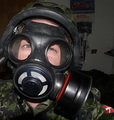
Fission (A-Bomb) & Fusion (H-Bomb)
There are two types of atomic explosions that can be facilitated by U-235: fission and fusion. Fission, simply put, is a nuclear reaction in which an atomic nucleus splits into fragments, usually two fragments of comparable mass, emitting 100 million to several hundred million volts of energy. This energy is expelled explosively and violently in the atomic bomb. A fusion reaction is usually started with a fission reaction, but unlike the fission (atomic) bomb, the fusion (hydrogen) bomb derives its power from the fusing of nuclei of various hydrogen isotopes into helium nuclei. This article discusses the A-bomb or atomic bomb.
The massive power behind the reaction in an atomic bomb arises from the forces that hold the atom together. These forces are akin to, but not quite the same as, magnetism.
Atoms are comprised of various numbers and combinations of the three sub-atomic particles: protons, neutrons and electrons. Protons and neutrons cluster together to form the nucleus (central mass) of the atom while the electrons orbit the nucleus much like planets around a sun. It is the balance and arrangement of these particles that determine the stability of the atom.
Most elements have very stable atoms which are impossible to split except by bombardment in particle accelerators. For all practical purposes, the only natural element whose atoms can be split easily is uranium, a heavy metal with the largest atom of all natural elements and an unusually high neutron-to-proton ratio. This higher ratio does not enhance its "splitability," but it does have an important bearing on its ability to facilitate an explosion, making uranium-235 an exceptional candidate for nuclear fission.
There are two naturally-occurring isotopes of uranium. Natural uranium consists mostly of isotope U-238, with 92 protons and 146 neutrons (92+146=238 ) per atom. Mixed with this is a 0.6% accumulation of U-235, with only 143 neutrons per atom. The atoms of this lighter isotope can be split, thus it is "fissionable" and useful in making atomic bombs. Neutron-heavy U-238 has a role to play in the atomic bomb as well since its neutron-heavy atoms can deflect stray neutrons, preventing an accidental chain reaction in a uranium bomb and keeping neutrons contained in a plutonium bomb. (U-238 can also be "saturated" to produce plutonium (Pu-239), a man-made, radioactive element also used in atomic bombs.)

 Bar by Mees
Bar by Mees












